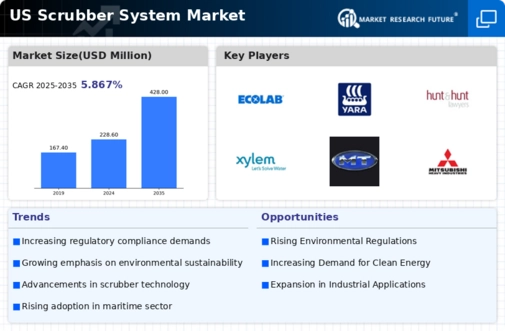Rising Industrialization
The scrubber system market is significantly influenced by the rising industrialization in the US. As industries expand, the demand for energy and raw materials increases, leading to higher emissions of pollutants. Consequently, industries such as power generation, oil and gas, and manufacturing are increasingly adopting scrubber systems to mitigate their environmental impact. The market is expected to reach a valuation of $3 billion by 2027, reflecting a robust growth trajectory. This trend indicates that as industrial activities intensify, the need for effective air pollution control technologies, including scrubbers, will likely escalate, thereby driving market expansion.
Growing Awareness of Air Quality
The growing awareness of air quality issues among the public and industries is a significant driver for the scrubber system market. As communities become more informed about the health impacts of air pollution, there is increasing pressure on industries to adopt cleaner technologies. This heightened awareness leads to greater demand for scrubber systems that effectively reduce harmful emissions. Furthermore, organizations are increasingly prioritizing corporate social responsibility, which includes investing in technologies that improve air quality. This trend suggests that the scrubber system market will continue to expand as industries respond to public concerns and strive for sustainable practices.
Increasing Environmental Regulations
The scrubber system market is experiencing growth due to the increasing environmental regulations imposed by federal and state agencies in the US. These regulations aim to reduce air pollution and greenhouse gas emissions from industrial sources. As industries face stricter compliance requirements, the demand for effective scrubber systems rises. For instance, the Environmental Protection Agency (EPA) has set stringent limits on emissions from power plants and manufacturing facilities. This regulatory landscape compels companies to invest in advanced scrubber technologies to meet compliance standards. The market is projected to grow at a CAGR of approximately 6% over the next five years, driven by the need for cleaner production processes and adherence to environmental laws.
Investment in Renewable Energy Sources
Investment in renewable energy sources is emerging as a key driver for the scrubber system market. As the US transitions towards cleaner energy solutions, there is a growing need for technologies that can manage emissions from both traditional and renewable energy sources. For instance, biomass and waste-to-energy facilities often require scrubber systems to control emissions effectively. The market is likely to benefit from the increasing funding and incentives for renewable energy projects, which often include provisions for emission control technologies. This trend indicates a promising future for the scrubber system market as it aligns with the broader shift towards sustainable energy practices.
Technological Innovations in Scrubber Systems
Technological innovations play a crucial role in shaping the scrubber system market. Recent advancements in scrubber technologies, such as the development of more efficient wet and dry scrubbers, enhance the effectiveness of pollutant removal. These innovations not only improve operational efficiency but also reduce maintenance costs for industries. The integration of automation and smart technologies in scrubber systems allows for real-time monitoring and optimization of performance. As industries seek to enhance their environmental compliance and operational efficiency, the adoption of these advanced scrubber systems is likely to increase, further propelling market growth.

















Leave a Comment